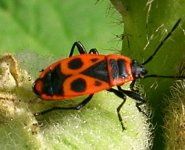Hi friends,
I have thousands of these in my garden where I live to the west of Paris. The French call them 'gendarmes'. They live on my Hollyhocks sunning themselves and in the seed heads, amongst woody herbs like sage, and cluster along low walls and tree bark.
What I don't know, and neither do my neighbours, is what they are living on, and whether I should be taking steps to control their numbers. And if so how.
Can anyone help please?
With thanks
Mike m47
I have thousands of these in my garden where I live to the west of Paris. The French call them 'gendarmes'. They live on my Hollyhocks sunning themselves and in the seed heads, amongst woody herbs like sage, and cluster along low walls and tree bark.
What I don't know, and neither do my neighbours, is what they are living on, and whether I should be taking steps to control their numbers. And if so how.
Can anyone help please?
With thanks
Mike m47





